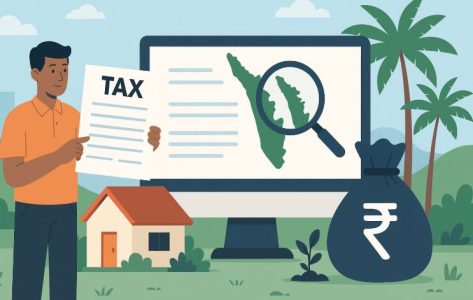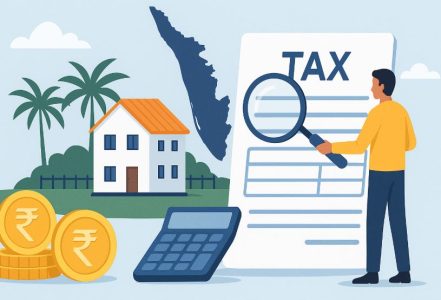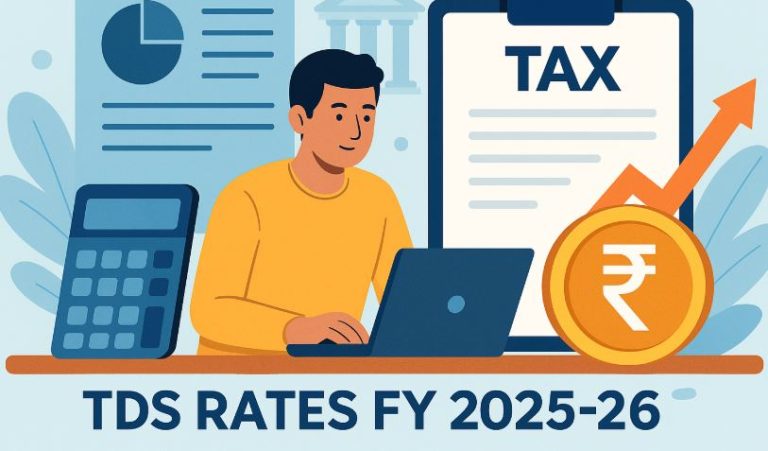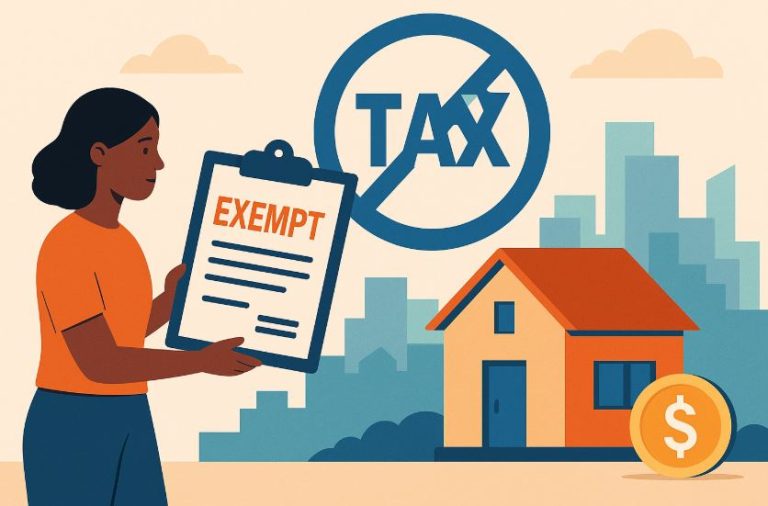Are you a property owner in Kerala wondering how much land tax you need to pay in 2025 and how to do it online? With new updates in the Kerala Budget 2025–26 and rapid digitalisation by the Revenue Department, understanding land tax has become essential.
Whether you’re a resident, an investor, or a legal heir managing inherited land, it’s crucial to know the updated rates, rules, and steps to ensure compliance.
This blog will guide you through everything you need to know about land tax in Kerala for 2025, including how to calculate it, pay it online, verify land details, and understand the latest policy changes.
You’ll also learn about tools like ReLIS, Revenue eServices, and e-Maps that have made land tax management easier than ever.
What is Land Tax in Kerala?

Land tax in Kerala is a statutory financial obligation imposed by the Revenue Department on all property and landowners. It is collected annually or bi-annually and contributes significantly to the state’s revenue system.
Key Facts About Land Tax
- It is governed by the Kerala Land Tax Act, 1961, which mandates payment by anyone owning land, regardless of how the property was acquired.
- The tax amount is calculated based on land area, location, and usage (residential, agricultural, commercial).
- It ensures proper documentation, helps prevent encroachment, and serves as evidence in legal land disputes.
Paying land tax keeps the ownership records updated and ensures that you remain compliant with government laws. It also acts as a foundation for any land-related transaction like sale, lease, or inheritance.
How Has Kerala’s Land Tax System Evolved Over Time?
The roots of Kerala’s land tax system trace back to the colonial era, where a structured form of land revenue was introduced. Over the decades, the process has evolved dramatically.
Timeline of Evolution
- Pre-Independence: British administration implemented manual land surveys and tax structures.
- Post-1961: The Kerala Land Tax Act formalised the structure and made it uniform across the state.
- 2011 Onwards: Introduction of the ReLIS system (Revenue Land Information System) marked the beginning of digital transformation.
- 2015: Integration with Registration and Survey Departments further improved transparency and accuracy.
- 2020s: Major advancements like online payments, e-maps, and mobile-friendly services took shape.
Kerala now stands as one of the leading states in India for digitised land revenue management.
What Are the New Land Tax Rates in Kerala for 2025?

The Kerala State Budget 2025–26 has introduced a substantial revision in land tax rates, with a 50% hike across various slabs. This reform aims to generate an additional Rs. 100 crores in revenue.
Revised Land Tax Rates (2025)
| Area Type | Land Parcel Size | Old Rate (Rs./Are) | New Rate (Rs./Are) |
| Panchayat Areas | Up to 8.1 Ares | 5 | 7.5 |
| Panchayat Areas | Above 8.1 Ares | 8 | 12 |
| Municipal Council | Up to 2.43 Ares | 10 | 15 |
| Municipal Council | Above 2.43 Ares | 15 | 22.5 |
| Municipal Corporation | Up to 1.62 Ares | 20 | 30 |
| Municipal Corporation | Above 1.62 Ares | 30 | 45 |
This change addresses the loss in central funds due to the discontinuation of GST compensation and a reduction in central tax devolution. It will help sustain Kerala’s welfare programs and infrastructure development.
Resource: https://www.bajajfinserv.in/kerala-land-tax
How is Land Tax Calculated in Kerala?
Calculating land tax is a straightforward process when you understand the factors that influence it.
Steps to Calculate Land Tax
1. Identify Land Category
- Patta land: Privately owned with legal titles
- Poramboke land: Government-owned or unclassified land
2. Determine Area and Location
Rates vary depending on whether the land lies in a Panchayat, Municipality, or Corporation zone.
3. Apply the Formula
Land Tax = Land Area (in Ares) × Applicable Rate per Are
Example: If your land in a Municipal Council area is 2 Ares and the rate is Rs. 15 per Are, the tax would be:
2 × 15 = Rs. 30 per year
4. Add Additional Charges
- Development charges
- Welfare fund contributions (if any)
- Penalty (for late payment)
Calculators are available on the official portal for a more precise estimate.
What is the Process to Pay Kerala Land Tax Online in 2025?

Thanks to the Kerala Revenue Department’s integrated online services, paying land tax is now a convenient and user-friendly experience.
Steps to Pay Land Tax Online
1. Visit the Official Website
Access the Kerala Revenue Department portal or the ReLIS payment system.
2. Register/Login
Use your Aadhaar, phone number, and email to create an account. Existing users can log in directly.
3. Enter Property Details
Provide information like:
- District, Taluk, Village
- Survey Number or Thandapper Number
4. Review Tax Dues
The system automatically fetches the tax based on your land data.
5. Make Payment
Choose a mode such as:
- Net banking
- UPI
- Debit/Credit cards
6. Receive Confirmation
Download or print the digital receipt and keep it for future use.
This method is operational across all online-activated villages since 2015.
Which Documents Are Required for Land Tax Payment in Kerala?
To ensure a seamless payment process, you must keep certain documents ready.
Essential Documents
- Property Tax Bill: Contains owner name, tax amount, and location
- Property Identification Number: Also known as the Thandapper number
- Owner’s Identity Proof: Aadhaar, Voter ID, or similar
- Survey or Sub-Division Number
- Tax Receipt (for old payments)
These details help auto-fetch records and avoid duplication or disputes.
How to Check Land Ownership and Tax Dues Online?

The Kerala Revenue Department provides an online verification portal to check ownership, outstanding dues, and transaction records.
Steps to Verify Land Records
1. Go to the ‘Verify Land’ Section
Choose from the following:
- Pokkuvaravu (Mutation)
- Tax Receipt Number
- Tax Dues or Ownership Report
2. Input Required Fields
- District, Taluk, Village
- Survey Number
- Year of transaction or document ID
3. View Results
The platform will show:
- Ownership name
- Land area
- Tax paid or due
- Mutation status
This verification is essential during buying, selling, or inheriting property.
Resource: https://revenue.kerala.gov.in/
What is the Role of ReLIS and Revenue eServices in Kerala?
The government has built a robust digital ecosystem to manage land tax and revenue services.
Revenue eServices
A unified platform offering:
- Tax payment
- Certificate generation
- Emergency document requests
It is mobile-friendly and stores all remittance history, reducing paperwork.
ReLIS (Revenue Land Information System)
Developed in 2011 and revamped in 2015 to:
- Integrate land survey, registration, and mutation records
- Enable digital backbone for land governance
- Provide transparency and efficiency in revenue collection
Both platforms significantly reduce the administrative burden on citizens and government officials.
How Do e-Maps Improve Transparency in Land Records?

e-Maps is a GIS-integrated service that combines spatial and textual land data for enhanced clarity in land management.
e-Maps Features
- Ground-Truth Verified Mapping: Digital verification of cadastral maps ensures accuracy in land shapes and boundaries.
- Real-Time Parcel Sketching: Users can view updated maps of individual plots within village boundaries.
- End-to-End Record Management: Facilitates mutation, title updation, and dispute resolution.
This helps maintain conclusive land titles and minimises conflicts in land ownership.
What Are the Common Issues in Online Land Tax Payment and How to Fix Them?
Despite digitalisation, some users may face technical or record-related issues.
Typical Challenges
- Payment Failure: Check bank statement for debit confirmation and retry after clearing browser cache.
- Incorrect Tax Amount: Visit the local revenue office to verify your land classification and size.
- Portal Access Issues: High traffic during month-end may slow down the site. Try early mornings or late evenings.
- Missing Receipts: Use the portal’s dashboard or login area to regenerate receipts from the payment history.
Always keep your Thandapper number and old receipts handy for faster resolution.
What’s the Future of Land Tax Digitalisation in Kerala?
Kerala is aiming for full digital transformation in land management.
Goals for the Future
- Promote digital literacy, especially in rural areas
- Enhance mobile accessibility through apps like Sandes
- Collaborate with organisations like Kerala Housing Board for inclusion
- Improve the UI/UX of portals for better user experience
- Enable multilingual support for non-English speakers
By addressing infrastructural gaps, Kerala can create a transparent and inclusive digital land governance system.
Conclusion
Land tax in Kerala plays a vital role in property ownership, legal protection, and state development. With the 2025 reforms, citizens must stay informed about the latest rates, policies, and tools provided by the Revenue Department.
Through platforms like ReLIS, Revenue eServices, and e-Maps, the state has made remarkable strides in simplifying land management.
Whether you’re calculating dues, making payments, or verifying records, everything is now just a few clicks away.
Being proactive with your land tax responsibilities not only saves time and avoids penalties but also contributes to the state’s mission of transparency and growth.
FAQs
Who can pay the land tax in Kerala?
The landowner, legal heirs, or an authorised person with a valid power of attorney can pay the land tax.
Can I pay land tax online in Kerala?
Yes, you can pay through the official Kerala Revenue Department portal or ReLIS system using digital payment methods.
How can I get the property tax bill online in Kerala?
After logging into the portal, navigate to the tax section, input your property details, and download the bill.
What are the types of land tax in Kerala?
Primarily based on land usage and location, including agricultural, residential, and commercial taxes.
Why is paying land tax in Kerala mandatory for landowners?
It ensures legal ownership, prevents disputes, updates government records, and contributes to public services.
What is the Thandapper number in land records?
It is the unique identification number assigned to a property used for land tax and record verification.
Is there any penalty for delayed land tax payment?
Yes, a delay in payment can attract fines or legal complications depending on the duration of default.
Disclaimer:
This content is for informational purposes only. The land tax structures, rates, and features mentioned here are based on the official information provided by the Kerala Revenue Department and other sources, including:
Users are advised to visit the official websites or consult local authorities to verify details and updates before taking any action.




